Athenian Democracy › Athena › Twelve Greatest Illuminated Manuscripts » Origins and History
Articles and Definitions › Contents
- Athenian Democracy › Origins
- Athena › Who Was
- Twelve Greatest Illuminated Manuscripts › Origins
Ancient civilizations › Historical places, and their characters
Athenian Democracy › Origins
Definition and Origins
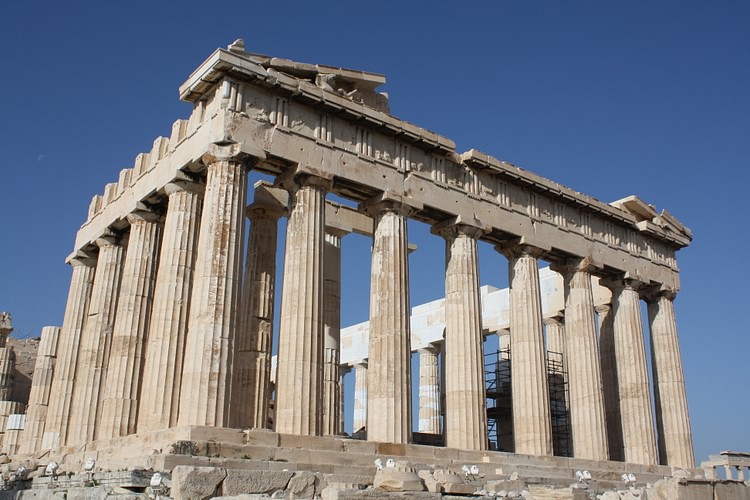
Athens in the 5th to 4th century BCE had an extraordinary system of government, whereby all male citizens had equal political rights, freedom of speech, and the opportunity to participate directly in the political arena. This system was democracy. Further, not only did citizens participate in a direct democracy whereby they themselves made the decisions by which they lived, but they also actively served in the institutions that governed them, and so they directly controlled all parts of the political process.
HISTORICAL SOURCES
Other city-states had at one time or another systems of democracy, notably Argos, Syracuse, Rhodes, and Erythrai. In addition, sometimes even oligarchic systems could involve a high degree of political equality, but the Athenian version, starting from c. 460 BCE and ending c. 320 BCE and involving all male citizens, was certainly the most developed.
The contemporary sources which describe the workings of democracy typically relate to Athens and include such texts as the Constitution of the Athenians from the School of Aristotle; the works of the Greek historians Herodotus, Thucydides, and Xenophon; texts of over 150 speeches by such figures as Demosthenes; inscriptions in stone of decrees, laws, contracts, public honours and more; and Greek Comedy plays such as those by Aristophanes. Unfortunately, sources on the other democratic governments in ancient Greece are few and far between. This being the case, the following remarks on democracy are focussed on the Athenians.
ANY CITIZEN COULD SPEAK TO THE ASSEMBLY AND VOTE ON DECISIONS BY SIMPLY HOLDING UP THEIR HANDS. THE MAJORITY WON THE DAY.
THE INSTITUTIONS OF DEMOCRACY
The word democracy (dēmokratia) derives from dēmos, which refers to the entire citizen body, and kratos, meaning rule. Any male citizen could, then, participate in the main democratic body of Athens, the assembly (ekklēsia). In the 4th and 5th centuries BCE the male citizen population of Athens ranged from 30,000 to 60,000 depending on the period. The assembly met at least once a month, more likely two or three times, on the Pnyx hill in a dedicated space which could accommodate around 6000 citizens. Any citizen could speak to the assembly and vote on decisions by simply holding up their hands. The majority won the day and the decision was final. Nine presidents (proedroi), elected by lot and holding the office one time only, organised the proceedings and assessed the voting.
Specific issues discussed in the assembly included deciding military and financial magistracies, organising and maintaining food supplies, initiating legislation and political trials, deciding to send envoys, deciding whether or not to sign treaties, voting to raise or spend funds, and debating military matters. The assembly could also vote to ostracise from Athens any citizen who had become too powerful and dangerous for the polis. In this case there was a secret ballot where voters wrote a name on a piece of broken pottery (ostrakon). An important element in the debates was freedom of speech (parrhēsia) which became, perhaps, the citizen's most valued privilege. After suitable discussion, temporary or specific decrees (psēphismata) were adopted and laws (nomoi) defined. The assembly also ensured decisions were enforced and officials were carrying out their duties correctly.

Ostraka for Themistocles
There was in Athens (and also Elis, Tegea, and Thasos) a smaller body, the boulē, which decided or prioritised the topics which were discussed in the assembly. In addition, in times of crisis and war, this body could also take decisions without the assembly meeting. The boulē or council was composed of 500 citizens who were chosen by lot and who served for one year with the limitation that they could serve no more than two non-consecutive years. The boulē represented the 139 districts of Attica and acted as a kind of executive committee of the assembly. It was this body which supervised any administrative committees and officials on behalf of the assembly.
Then there was also an executive committee of the boulē which consisted of one tribe of the ten which participated in the boulē (i.e., 50 citizens, known as prytaneis) elected on a rotation basis, so each tribe composed the executive once each year. This executive of the executive had a chairman (epistates) who was chosen by lot each day. The 50-man prytany met in the building known as the Bouleuterion in the Athenian agora and safe-guarded the sacred treasuries.
In tandem with all these political institutions were the law courts (dikasteria) which were composed of 6,000 jurors and a body of chief magistrates (archai) chosen annually by lot. Indeed, there was a specially designed machine of coloured tokens (kleroterion) to ensure those selected were chosen randomly, a process magistrates had to go through twice. It was here in the courts that laws made by the assembly could be challenged and decisions were made regarding ostracism, naturalization, and remission of debt.

Kleroteria
This complex system was, no doubt, to ensure a suitable degree of checks and balances to any potential abuse of power, and to ensure each traditional region was equally represented and given equal powers. With people chosen at random to hold important positions and with terms of office strictly limited, it was difficult for any individual or small group to dominate or unduly influence the decision-making process either directly themselves or, because one never knew exactly who would be selected, indirectly by bribing those in power at any one time.
PARTICIPATION IN GOVERNMENT
As we have seen, only male citizens who were 18 years or over could speak (at least in theory) and vote in the assembly, whilst the positions such as magistrates and jurors were limited to those over 30 years of age. Therefore, women, slaves, and resident foreigners (metoikoi) were excluded from the political process.
The mass involvement of all male citizens and the expectation that they should participate actively in the running of the polis is clear in this quote from Thucydides: "We alone consider a citizen who does not partake in politics not only one who minds his own business but useless". Illustrating the esteem in which democratic government was held, there was even a divine personification of the ideal of democracy, the goddess Demokratia. Direct involvement in the politics of the polis also meant that the Athenians developed a unique collective identity and probably too, a certain pride in their system, as shown in Pericles' famous Funeral Oration for the Athenian dead in 431 BCE, the first year of the Peloponnesian War:
Athens' constitution is called a democracy because it respects the interests not of a minority but of the whole people. When it is a question of settling private disputes, everyone is equal before the law; when it is a question of putting one person before another in positions of public responsibility, what counts is not membership of a particular class, but the actual ability which the man possesses. No one, so long as he has it in him to be of service to the state, is kept in political obscurity because of poverty. (Thuc. 2.37)
Although active participation was encouraged, attendance in the assembly was paid for in certain periods, which was a measure to encourage citizens who lived far away and could not afford the time off to attend. This money was only to cover expenses though, as any attempt to profit from public positions was severely punished. Citizens probably accounted for 10-20% of the polis population, and of these it has been estimated that only 3,000 or so people actively participated in politics. Of this group, perhaps as few as 100 citizens - the wealthiest, most influential, and the best speakers - dominated the political arena both in front of the assembly and behind the scenes in private conspiratorial political meetings (xynomosiai) and groups (hetaireiai). These groups had to meet secretly because although there was freedom of speech, persistent criticism of individuals and institutions could lead to accusations of conspiring tyranny and so lead to ostracism.
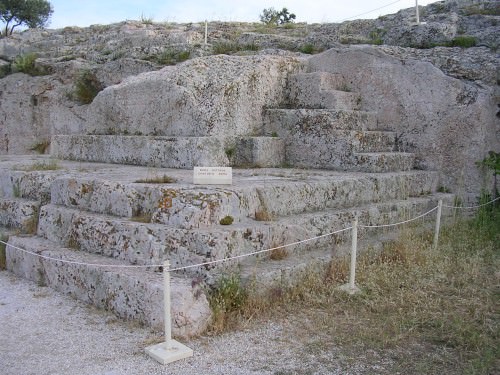
Speaker's Platform, Athens Assembly, Pynx, Athens
Critics of democracy, such as Thucydides and Aristophanes, pointed out that not only were proceedings dominated by an elite, but that the dēmos could be too often swayed by a good orator or popular leaders (the demagogues), get carried away with their emotions, or lack the necessary knowledge to make informed decisions. Perhaps the most notoriously bad decisions taken by the Athenian dēmos were the execution of six generals after they had actually won the battle of Arginousai in 406 BCE and the death sentence given to the philosopher Socrates in 399 BCE.
CONCLUSION
Democracy, which had prevailed during Athens’ Golden Age, was replaced by a system of oligarchy after the disastrous Athenian defeat in Sicily in 409 BCE. The constitutional change, according to Thucydides, seemed the only way to win much-needed support from Persia against the old enemy Sparta and, further, it was thought that the change would not be a permanent one. Nevertheless, democracy in a slightly altered form did eventually return to Athens and, in any case, the Athenians had already done enough in creating their political system to eventually influence subsequent civilizations two millennia later.
In the words of historian K. A. Raaflaub, democracy in ancient Athens was
a unique and truly revolutionary system that realized its basic principle to an unprecedented and quite extreme extent: no polis had ever dared to give all its citizens equal political rights, regardless of their descent, wealth, social standing, education, personal qualities, and any other factors that usually determined status in a community.
Ideals such as these would form the cornerstones of all democracies in the modern world. The ancient Greeks have provided us with fine art, breath-taking temples, timeless theatre, and some of the greatest philosophers, but it is democracy which is, perhaps, their greatest and most enduring legacy.
Athena › Who Was
Definition and Origins
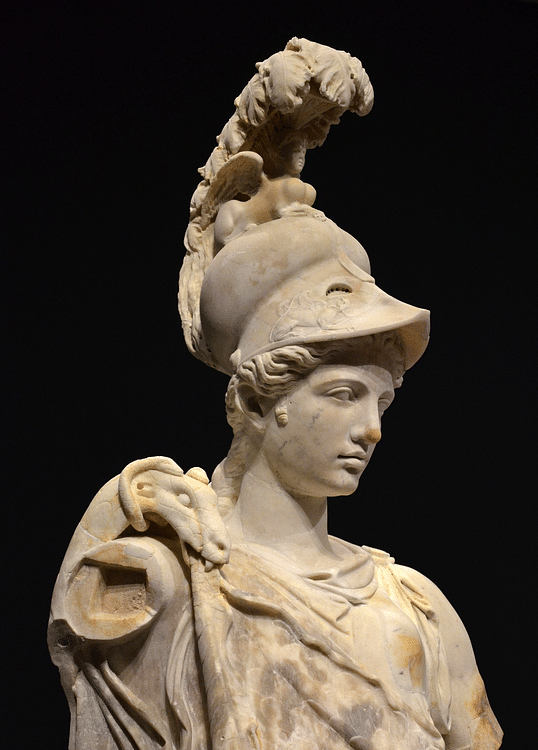
Goddess of wisdom, war and the crafts, and favourite daughter of Zeus, Athena was, perhaps, the wisest, most courageous, and certainly the most resourceful of the Olympian gods.
Zeus was told that his son would take his throne from him, just as he had taken power from his father Cronus. Accordingly, when Metis was pregnant, he swallowed her and Athena was born from Zeus’ head, wearing armour and fully grown. A popular theme in ancient art, Hephaistos is often depicted in the role of midwife, splitting Zeus’ head with an axe.
Epithets of Athena include Pallas (girl) and Parthenos (virgin), living up to which, she is conspicuous amongst the gods for not indulging in illicit relationships with other divinities, demi-gods, or mortals. Other epithets were Promachos (of war) - perhaps referring to more patriotic, defensive, and strategic warfare, rather than attacking warfare, in contrast to her more aggressive, conflict-loving brother Ares, Ergane (of the crafts), and Nike (victory).
ATHENA WAS NOT TO BE TRIFLED WITH AS HER TRANSFORMATION OF MEDUSA INTO A GORGON DEMONSTRATES.
The goddess was not to be trifled with as her transformation of Medusa into a Gorgon demonstrates, and her sense of justice was such that acts of impiety were swiftly avenged, as with the Archaean heroes following their capture of Troy and desecration of the goddess’ sanctuary.
Athena is also associated with household crafts, giving mortals the gifts of cooking and sewing. She is said to have invented the aulos but on seeing her reflection and her puffed cheeks when playing these pipes, she threw them away, to be picked up by the satyr Marsyas.
She is closely associated with Athens, the city named in her honour after the people of Attica chose her as their patron following her gift of the olive tree, symbol of peace and plenty. The 5th century BCE temple of the Parthenon, which continues to this day to dominate the acropolis of the city, was built in her honour. Her adopted son Erichthonios, one of the first kings of Athens, is traditionally credited with inaugurating the Panathenaic festival, held every four years to honour the goddess. The festival included a magnificent procession through the city, the presentation to Athena of a specially woven peplos(depicting the Gigantomachy), and athletic games. Prizes for the games were amphoraepainted with a figure of Athena and contained prime olive oil. In her role as protector, she was also revered in many other major cities, notably as patron of Sparta, as the founder of Thebes in Boeotia, and at Corinth where she appeared on the city’s coins.
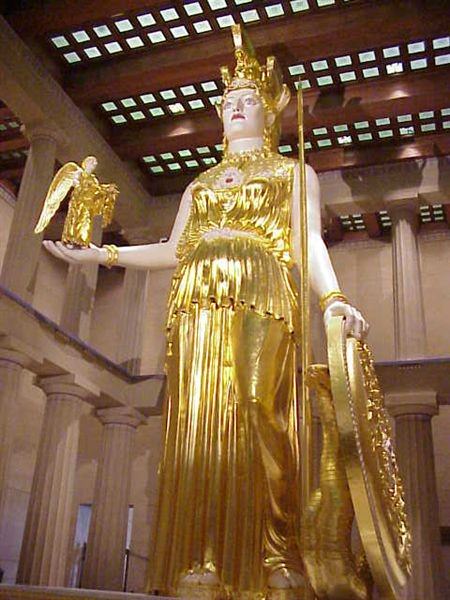
Athena Parthenos
Protector of Herakles, Athena often aids him in his twelve labours, for example, by helping him hold the world as Atlassearches for the sacred apples of the Hesperides. Perseus was another favourite and was given a shield to protect himself in his quest to kill Medusa. Achilles is helped to kill Hektor, and Odysseus too was often given the benefit of Athena’s wisdom, for example the idea to dress as a beggar on his return to Ithaca, and he is also protected from the arrows of his rivals when he clears the palace of the interlopers. Jason was yet another hero who benefitted from Athena’s resourcefulness when she encouraged Argo to build the first Greek long ship which would carry his name and the fame of the Argonauts.
Athena was a major protagonist in Homer’s account of the Trojan War in the Iliad where she supports the Archaeans and their heroes, especially Achilles, to whom she gives encouragement and wise counsel, Menelaos, who is saved from the arrow of Pandaros, and Diomedes, whose spear, in one notable episode, is diverted to injure Ares himself. Aphrodite was another divinity who came off second best when she clashed with Athena. She also gave protection to Odysseus and is credited with giving him the idea of the Wooden Horse. Both Homer and Hesiod refer to Athena as ‘bright-eyed’ and ‘Tritogeneia’. She is also frequently called ‘goddess of spoil’, the ‘lovely-haired goddess’, and ‘Alalkomenaian Athena’
Objects associated with the goddess include an owl - symbol of wisdom - and the olive tree. She is often depicted in art with armour, a golden helmet, a shield, and holding a spear. Her armour is the aegis made, in some accounts, from the skin of a Giant, hung with tassels of gold, and featuring the head of the Gorgon given to her by Perseus. The most famous representation of Athena in the ancient world was undoubtedly the monumental gold and ivory statue of the goddess by Pheidias which resided in the Parthenon of Athens and was over 12 m high. The statue has been lost but survives in the form of smaller Roman copies and shows Athena standing majestic, fully armed, holding Nike in her right hand and with a shield in her left depicting scenes from the Battles of the Amazons and the Giants. On her helmet were a sphinx and two griffins. Celebrated surviving depictions of Athena include friezes from the Parthenon and metopes from the temple of Zeus at Olympia.
Twelve Greatest Illuminated Manuscripts › Origins
Ancient Civilizations
Illuminated manuscripts are, as their name suggests, hand-made books illumined by goldand silver ink. They were produced in Western Europe between c. 500 and c. 1600 CE and their subject matter is usually Christian scripture, practice, and lore. The books are elaborately illustrated and their illumination comes from the use of brightly-colored inks painted on top of or ornamented by gold and silver ink.
Even though many manuscripts from the medieval period are often referred to as “illuminated”, the term technically applies only to those which make use of gold and silver ink. The fragments of a manuscript of Virgil’s works, for example, is often included in a discussion of illuminated manuscripts but does not technically meet the standard definition.
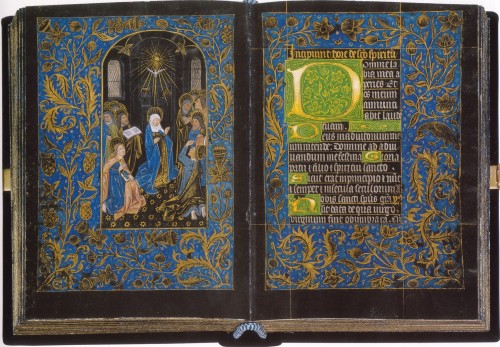
Black Hours
The most popular type of illuminated manuscript was the Book of Hours, which was comprised of Christian prayers to be said at certain hours throughout the day. Some of these are the most impressive works of their periods, elaborately decorated with intricate illustrations and lavishly illumined. More of these books have survived than any other because the demand for them was greater and so more were produced on commission.
Other types of illuminated manuscripts were copies of the Bible or just the four gospels, bestiaries, prayer books, biblical tales, and those which dealt with classical writers such as Virgil or Homer. These manuscripts were produced by monks in monasteries, abbeys, and priories and were quite costly because they took so long to make.
THE MOST POPULAR TYPE OF ILLUMINATED MANUSCRIPT WAS THE BOOK OF HOURS, WHICH WAS COMPRISED OF CHRISTIAN PRAYERS TO BE SAID AT CERTAIN HOURS THROUGHOUT THE DAY.
Only people of substantial means were able to afford to commission them. In time, nuns also began producing the manuscripts in their nunneries and, as literacy grew and books became more popular, professional book-makers became involved in order to meet the growing demand.
The invention of the printing press by Johannes Gutenberg in c. 1440 CE marked the beginning of the end of hand-made, illuminated books, but they remained popular among the wealthy, and some collectors, in fact, disdained printed books and continued to commission hand-made works. Even though Gutenberg’s press made books less costly and more available, it took about 20 years for print books to become a profitable venture. Gutenberg himself, in fact, never profited from the invention; his press was seized for debt shortly after its invention and any profits were made by his patron Johan Fust who perfected Gutenberg’s techniques and popularized the printed word.
Some of the most impressive illuminated manuscripts were actually created after Gutenberg’s invention and continued to be produced into the 17th century CE. Although there are many fine works, from the beginning of their production onwards, which are considered great works of art, the following are among those considered the greatest. They are listed in order of date of composition.
THE GREATEST ILLUMINATED MANUSCRIPTS
The Book of Durrow (650-700 CE) – The oldest illuminated book of the gospels created either at Iona or Lindisfarne Abbey. Scholar Christopher de Hamel describes the work:
It includes twelve interlaced initials, five full-page emblematic figures symbolizing the Evangelists, and six carpet pages, an evocative term used to describe those entire sheets of multicolored abstract interlace patterns so characteristic of early Irish art. Anyone can see that it is a fine manuscript. (20)
The book contains a number of striking illustrations and the carpet pages de Hamel makes note of are often adorned by intricate Celtic knot motifs entwined with animal imagery. The book was most likely used by missionaries as it is slim and, as de Hamel observes, “could easily slip into a traveller’s saddle-pack” (20). The work marks the first appearance of the Evangelists in illuminated manuscripts as well as the earliest known use of gold and silver ink to illumine the gospels.
Codex Amiatinus (c. late 7th – early 8th century CE) – The oldest version of St. Jerome’s Vulgate Bible. It was created in Northumbria, Britain, of 1040 sheets of fine vellum. The biblical narratives are illustrated by striking images brightly colored, although it is not technically “illuminated” since it makes no use of gold or silver ink. The work frequently devotes complete pages to these images which are known as “miniatures” in discussing illuminated manuscripts. It deserves a place among the greatest of these manuscripts for the mastery of its artwork.
Lindisfarne Gospels (c. 700-715 CE) – Created at the Lindisfarne Priory on the “Holy Island” off the coast of Dorset, Britain. It is an illustrated edition of the gospels of the New Testament made in honor of the priory’s most famous member, St. Cuthbert, and dedicated to the Glory of God. The priory was sacked by the Vikings in 793 CE – the first recorded Viking raid on Britain – but the book was somehow saved and moved to Durham, away from the coast, for safety. Along with the Book of Kells, the Lindisfarne Gospels is among the best-known and most admired illuminated manuscripts.

Lindisfarne Gospels
The Book of Kells (c. 800 CE) – Created either at Iona Abbey, Scotland, and brought to Kells, Ireland, in 806 CE or made at Kells, this is the most famous illuminated manuscript. The work is commonly regarded as the greatest illuminated manuscript of any era. Entomologist and palaeographer J.O. Westwood comments:
Ireland may justly be proud of the Book of Kells. This copy of the Gospels, traditionally asserted to have belonged to St. Columba, is unquestionably the most elaborately executed manuscript of early art now in existence, far excelling, in the gigantic size of the letters in the frontspieces of the Gospel, the excessive minuteness of the ornamental details, the number of its decorations, the fineness of the writing, and the endless variety of initial capital letters, with which every page is ornamented, the famous Gospels of Lindisfarne. (Book of Kells Chapter, 2)
Westwood here repeats a common misconception regarding the Book of Kells – that it was produced, or at least owned, by St. Columba (521-597 CE) who founded the abbey at Iona. Recent scholarship, however, has firmly established that the work was produced no earlier than c. 800 CE.

Book of Kells
St. Albans Psalter (c. 1120 - c. 1145 CE) – Created at St. Alban’s Abbey in Britain, this is a lavishly illustrated and illuminated book of Psalms and literature. It was commissioned by the scholar Geoffrey de Gorham who was abbot of St. Alban’s between 1119-1146 CE. It was either made for or later given to Geoffrey’s close friend Christina of Markyate (c. 1098 - c. 1155 CE), a visionary prioress whom he held in high esteem. The Psalter is widely admired for the detail and beauty of the artwork. It contains over 40 illustrations, all magnificently bordered and intricately wrought, designed to complement and honor the subject matter.
The Morgan Crusader Bible (c. 1250 CE) – Created in Paris and most likely for Louis IX (1214-1270 CE) who participated in the 7th and 8th Crusades and died of dysentery at the start of the 8th. The Morgan Crusader Bible was originally a work only of full-color illustrations, but later owners seem to have felt compelled to add text to complement the images. This practice is the complete reverse of how illuminated manuscripts were usually created, where the text was written first and then handed to an artist to illustrate and an illuminator to adorn. The purpose of the original work, without text, seems to have been the same as later: to present biblical narratives in an accessible form. Even so, the work contains a number of fascinating lay subjects having nothing to do with the Bible accompanying biblical text. The Morgan Crusader Bible is considered one of the greatest illuminated manuscripts of all time and an artistic masterpiece of the Middle Ages.
The Westminster Abbey Bestiary (c. 1275-1290 CE) – Created most likely in York, Britain. A bestiary is a book of animals, real or imaginary, defined and accompanied by illustrations. This genre originated in Greece in the 2nd century CE but was most popular during the Middle Ages when a number of them were produced to show a correlation between the natural world and the Christian vision of the Bible. The Westminster Abbey Bestiary is a fine example of this type of work. Drawing on both pre-Christian and biblical stories, the book presents an array of fascinating creatures across its 164 illustrations, each one represented in striking detail.
The Book of Hours of Jeanne d’Evreux (c. 1324-1328 CE) – Created in Paris, France by the leading illustrator of the time, Jean Pucelle, for the queen Jeanne d’Evreux (1310-1371 CE), wife of Charles IV (1322-1328 CE). It is an amazing artistic masterpiece of 25 full-page paintings representing the life of Jesus Christ as well as a number of smaller illustrations, totaling over 700. The text, of course, presents the prayers a faithful Christian would recite throughout the day, and the illustrations are intended to inspire and elevate the reader. The work is all the more impressive for its size: it is smaller than a modern-day paperback. Among the many surviving examples of a Book of Hours, this is easily one of the most impressive.
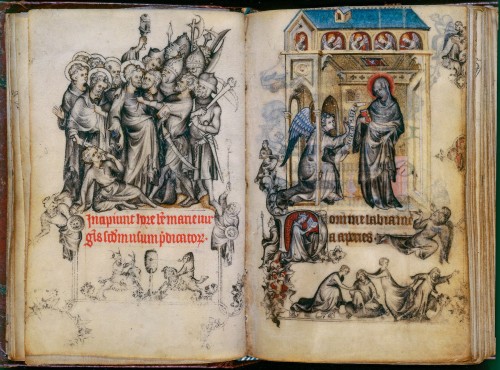
Book of Hours of Jeanne d'Evreux
The Black Hours (c. 1475-1480 CE) – Created in Bruges, Belgium by an anonymous artist working in the style of the leading illustrator of the city, Wilhelm Vrelant who dominated the art c. 1450 CE until his death in 1481 CE. It is made of fine vellum which was carefully processed, stained black, and then illuminated in brilliant – almost mesmerizing - blue and gold. The images in blue and lighter colors are highlighted by the deep black of the background and the whole work gives a reader the impression of entering another realm. The text of the work adds to this impression as it is written in silver and gold ink. It is one of the most unique Books of Hours extant and easily one of the most impressive illuminated manuscripts.
Les Tres Riches Heures de Duc de Berry (c. 1412-1416 and 1485-1489 CE) – Even though The Black Hours is recognized and admired for its unique qualities, Les Tres Riches Heures is the most famous Book of Hours in the present day. It is regularly referenced as an absolute masterwork. The book was commissioned by Jean, Duke of Berry, Count of Poitiers, France (1340-1416 CE). It was left unfinished when the Duke, as well as the artists working on it, died of the plague in 1416 CE. The manuscript was discovered and completed between the years 1485-1489 CE. It is often referenced as the “king of illuminated manuscripts” because of the incredible grandeur of the miniatures and the obvious artistic skill required to create it. Biblical themes are brought vibrantly to life by the illustrators and illuminated so brilliantly that the images seem almost to move on the page. The work contains other images such as landscapes of the time, domestic scenes, a plan of Rome, and others not associated with biblical stories.
Grimani Breviary (c. 1510 CE) – This work is nearly legendary for its length and the beauty of the artwork. The book is comprised of 1,670 pages with full-page illustrations of scenes from the Bible, secular legend, and contemporary landscapes along with domestic scenes. The text is biblical in nature and includes prayers, psalms, and other selections from the Bible. It was probably made in Flanders but who created or commissioned it is unknown. The book was bought by the Venetian Cardinal Domenico Grimani (1461-1523 CE) in 1520 CE who declared it so beautiful that only select people of high moral standing should be allowed to see it and then only under special circumstances. In his will, Grimani stipulated that the book could never be sold and left it to Venice.
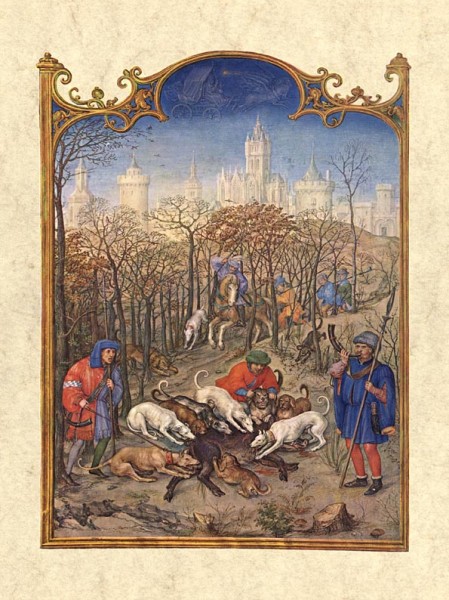
Grimani Breviary
Prayer book of Claude de France (c. 1517 CE) – Created for Claude, the queen of France (1514-1524 CE) along with an almost equally impressive Book of Hours. This work is one of the most unique illuminated manuscripts owing to its size: small enough to fit in the palm of one’s hand. As a prayer book, it would have been easily carried and read and its utilitarian purpose could have been met without illustrations. What makes the work so fascinating is that it is illustrated with 132 intricate images framed by elaborate and striking borders. Some of these images are so small that, today, they cannot be seen without the aid of a magnifying glass. Scholars remain in disagreement, in fact, on how these images were produced since the magnifying glass did not exist at the time the book was created.
CONCLUSION
As printed books became more popular in the 1460’s CE, those who made books by hand became highly esteemed by collectors. Scholar Giulia Bologna writes:
Even though it took at least six months for a speedy professional copyist to produce a single copy of a four-hundred-page book, printing did not immediately bring to an end the production of manuscripts. For the cultural, social, and political elites, illuminated manuscripts for long maintained a special prestige. Vespasiano de Bisticci claims that the great bibliophile Federigo da Montefeltro, Duke of Urbino, would have felt shame to have had a printed book in his library. (39)
The artists who worked on books such as the Grimani Breviary or the Prayer Book of Claude de France were working during a time when printed books were more widely accepted than they had been previously, but still, those who could afford to commission them preferred the beauty and craftsmanship of a hand-made, hand-illustrated work.
Publishers recognized this and tried to make their products appear more “legitimate” by decorating their covers with gold leaf and hiring illustrators to provide images for chapter headings, but for many years after the invention of the printing press, the wealthy continued to demand books made by hand, and among these are some of the greatest illuminated manuscripts of all time.
LICENSE
Article based on information obtained from these sources:with permission from the Website Ancient History Encyclopedia
Content is available under License Creative Commons: Attribution-NonCommercial-ShareAlike 3.0 Unported. CC-BY-NC-SA License